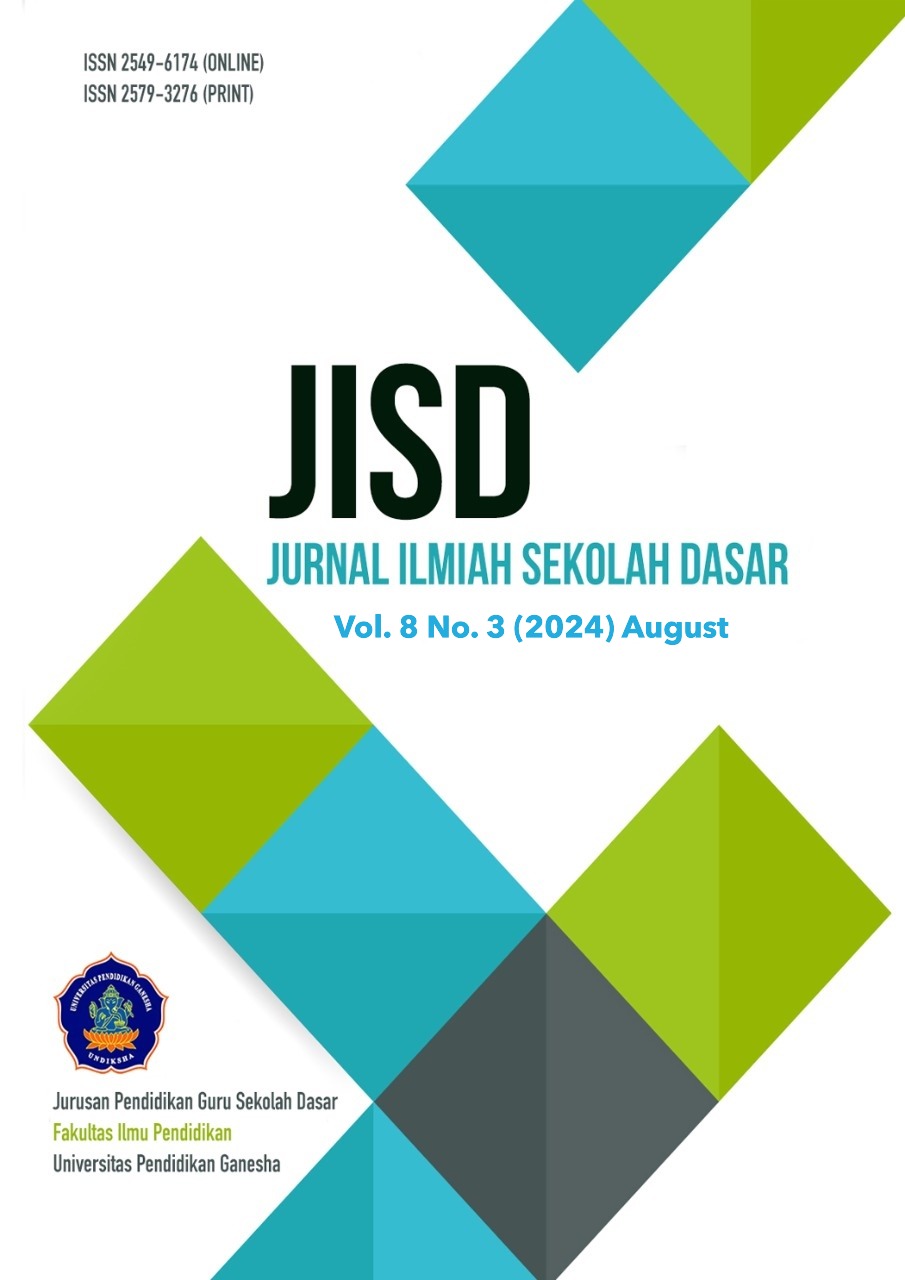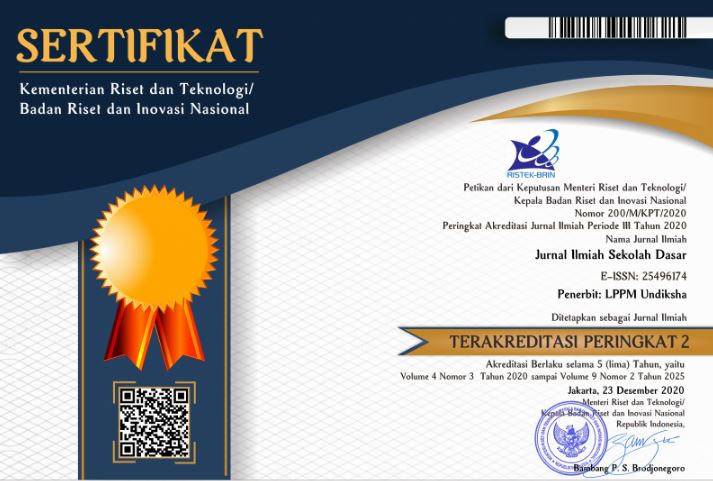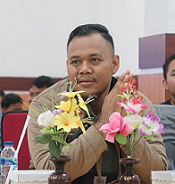Ethnomathematics-Collaborative Augmented Reality: An Innovative Framework to Enhance Problem-Solving Skills in Elementary Geometry
DOI:
https://doi.org/10.23887/jisd.v8i3.85666Keywords:
Problem Solving, Ethnomathematics, Augmented RealityAbstract
This study addresses the urgent need to develop problem-solving skills among elementary school students as a fundamental basis for effective learning processes. The research aims to analyze the effectiveness of a geometry framework based on ethnomathematics-collaborative augmented reality in enhancing students' problem-solving abilities. This experimental research employs a quantitative approach with a one-group pre-test post-test design. The study involved 30 fourth-grade elementary school students as subjects. The effectiveness of the framework was measured using pre-test and post-test methods. Data analysis was conducted using descriptive and inferential statistics, with the Paired Sample T-Test applied to test the hypothesis, utilizing IBM SPSS Statistics for Windows version 21.0. The results indicated a significant difference in students' problem-solving abilities before and after the implementation of the geometry framework. The post-test results showed a notable improvement in students' problem-solving skills compared to the pre-test. The application of the ethnomathematics-collaborative augmented reality framework proved effective in providing contextual, collaborative, and technology-based learning experiences, which significantly enhanced students' problem-solving capabilities. Therefore, this framework offers a relevant innovation in geometry learning for elementary education, promoting the integration of local cultural values into the learning process and supporting students’ cognitive development through problem-solving tasks.
References
Afriliziana, L. A., Maimunah., & Roza, Y. (2021). Analisis Kebutuhan Pengembangan E-Modul Etnomatematika Berbasis Budaya Melayu Kepulauan Riau. Jurnal Analisa, 7(2), 135–145. https://doi.org/10.15575/ja.v7i2.14753.
Apriadi, H. (2021). Video Animasi Matematika Dengan Pendekatan Kontekstual Untuk Meningkatkan Pemahaman Konsep Matematika. JNPM (Jurnal Nasional Pendidikan Matematika), 5(1), 173. https://doi.org/10.33603/jnpm.v5i1.3621.
Arisetyawan, A., Taher, T., & Fauzi, I. (2021). Integrating the Concept of Plane Figure and Baduy Local Wisdom as a Media Alternative of Mathematics Learning In Elementary Schools. Kreano, Jurnal Matematika Kreatif-Inovatif, 12(1), 1–13. https://doi.org/10.15294/kreano.v12i1.26288.
Atmaja, I. M. D. (2021). Koneksi Indikator Pemahaman Konsep Matematika Dan Keterampilan Metakognisi1. Nusantara: Jurnal Ilmu Pengetahuan Sosial, 8(7), 2048–2056.
https://doi.org/10.31604/jips.v8i7.2021.2048-2056.
Dewi, N. P. W. P., & Agustika, G. N. S. (2020). Efektivitas Pembelajaran Matematika Melalui Pendekatan PMRI Terhadap Kompetensi Pengetahuan Matematika. Jurnal Penelitian Dan Pengembangan Pendidikan, 4(2), 204. https://doi.org/10.23887/jppp.v4i2.26781.
Dinarti, S., & Qomariyah, U. N. (2022). Analisis strategi siswa sekolah dasar dalam memecahkan masalah generalisasi pola ditinjau dari gaya kognitif. AKSIOMA: Jurnal Matematika Dan Pendidikan Matematika, 13(2), 278–293. http://journal.upgris.ac.id/index.php/aksioma/article/view/12517.
Dwiyono, Y., & Tasik, H. K. (2021). Analisis Kesulitan Belajar Operasi Hitung Perkalian Matematika Siswa Kelas IV SD Negeri 019 Samarinda Ulu. Jurnal Ilmu Pendidikan LPMP Kalimantan Timur, 1, 175–190. https://repository.unmul.ac.id/bitstream/handle/123456789/23677/2. Jurnal Borneo Edisi Khusus Halaman 175-190-dikonversi.pdf?sequence=1.
Fathimah, N. S., & Ishartiwi, I. (2018). Pengembangan Multimedia Permainan Interaktif Pembelajaran Berhitung Bagi Anak Diskalkulia Usia Prasekolah. Jurnal Inovasi Teknologi Pendidikan, 5(2), 115–128. https://doi.org/10.21831/jitp.v5i2.15541.
Fatra, M., Jatmiko, M. A., Sihombing, A. A., & Zahroh, U. (2022). Keterampilan Berpikir Tingkat Tinggi (Hots) Siswa Madrasah Tsanawiyah. AKSIOMA: Jurnal Program Studi Pendidikan Matematika, 11(2), 1146. https://doi.org/10.24127/ajpm.v11i2.4909.
Fitriani, A. D. (2014). Pengembangan Multimedia Interaktif Dalam Pembelajaran Geometri Untuk Meningkatkan Kemampuan Komunikasi Calon Guru Sekolah Dasar. Edutech, 13(2), 236. https://doi.org/10.17509/edutech.v13i2.3105.
Fouze, A. Q., & Amit, M. (2021). Teaching geometry by integrating ethnomathematics of bedouin values. Creative Education, 12, 402–421. https://doi.org/10.4236/ce.2021.122029.
Gk, M., & Prahmana, R. (2019). Ethnomathematics: Exploration of the Muntuk Community. International Journal of Scientific & Technology Research, 8, 47–49.
Isroqmi, A. (2020). Software Aplikasi Pembuat Animasi Sebagai Alternatif Pengganti Alat Peraga Untuk Menanamkan Konsep Dasar Matematika. Indiktika : Jurnal Inovasi Pendidikan Matematika, 2(2), 146–158. https://doi.org/10.31851/indiktika.v2i2.4127.
Kartono. (2010). Hands On Activity Pada Pembelajaran Geometri Sekolah Sebagai Asesmen Kinerja Siswa. Kreano, Jurnal Matematika Kreatif-Inovatif, 1(1), 21–32.
https://doi.org/10.15294/kreano.v1i1.219.g228.
Mawaddah, S., & Anisah, H. (2015). Kemampuan Pemecahan Masalah Matematis Siswa Pada Pembelajaran Matematika dengan Menggunakag) di SMPn Model Pembelajaran Generatif (Generative Learning) di SMP. EDU-MAT: Jurnal Pendidikan Matematika, 3(2), 166–175.
https://doi.org/10.20527/edumat.v3i2.644.
Mida Astarina, Sumarno, & Achmad Buchori. (2023). Pengembangan Ar Book Math Berbasis Augmented Reality Pada Materi Volume Bangun Ruang Di Sekolah Dasar. Didaktik : Jurnal Ilmiah PGSD STKIP Subang, 9(04), 1318–1326. https://doi.org/10.36989/didaktik.v9i04.1715.
Muhassanah, N., Sujadi, I., & Riyadi. (2014). Analisis Keterampilan Geometri Siswa Dalam Memecahkan Masalah Geometri Berdasarkan Tingkat Berpikir Van Hiele. Jurnal Elektronik Pembelajaran Matematika, 2(1), 54–66. https://digilib.uns.ac.id/dokumen/detail/39827.
Mursyidah, D., & Saputra, E. R. (2022). Aplikasi Berbasis Augmented Reality sebagai Upaya Pengenalan Bangun Ruang bagi Siswa Sekolah Dasar. Tunas Nusantara, 4(1), 427–433.
https://doi.org/10.34001/jtn.v4i1.2941.
Nasution, M. D., & Oktaviani, W. (2020). Pengembangan Perangkat Pembelajaran Matematika Berbasis Masalah Untuk Meningkatkan Kemampuan Pemecahan Masalah Siswa SMP PAB 9 Klambir V T.P 2019/2020. Journal Mathematics Education Sigma [JMES], 1(2), 46–55.
https://doi.org/10.30596/jmes.v1i1.4390.
Nurhairunnisah, N., & Sujarwo, S. (2018). Bahan ajar interaktif untuk meningkatkan pemahaman konsep Matematika pada siswa SMA kelas X. Jurnal Inovasi Teknologi Pendidikan, 5(2), 192–203. https://doi.org/10.21831/jitp.v5i2.15320.
Nurmi, N., Yunita, A., Yusri, R., & Delyana, H. (2020). Efektivitas Penggunaan Lembar Kerja Mahasiswa Berbasis Project Based Learning (Pjbl) Terintegrasi ICT. AKSIOMA: Jurnal Program Studi Pendidikan Matematika, 9(4), 1018. https://doi.org/10.24127/ajpm.v9i4.3190.
Nursyifa, H. S., Abdul, D., Lidinillah, M., & Kosasih, E. (2020). Analisis Soal Hots Materi Geometri dalam Buku Teks Matematika Kelas IV SD. Jurnal Ilmiah Pendidikan Guru Sekolah Dasar, 7(4), 121–131. https://ejournal.upi.edu/index.php/pedadidaktika/article/view/26576.
Qodr, T. S., Efendi, A., & Musadad, A. A. (2021). Opportunities for Using Smartphones in the Digital Era to Facilitate Students in Learning Sociology in High Schools. Journal of Education Technology, 5(2), 263–271. https://doi.org/10.23887/jet.v5i2.34806.
Risdiyanti, I., & Prahmana, R. (2017). Ethnomathematics: Exploration in Javanese culture. Journal of Physics: Conference Series, 943, 12032. https://doi.org/10.1088/1742-6596/943/1/012032.
Septiani, D. R., & Purwanto, S. E. (2020). Hubungan Antara Kepercayaan Diri dengan Hasil Belajar Matematika Berdasarkan Gender. JKPM (Jurnal Kajian Pendidikan Matematika), 6(1), 141. https://doi.org/10.30998/jkpm.v6i1.7526.
Siswanto, R. D., & Ratiningsih, R. P. (2020). Korelasi Kemampuan Berpikir Kritis dan Kreatif Matematis dengan Kemampuan Pemecahan Masalah Matematis Materi Bangun 4uang. ANARGYA: Jurnal Ilmiah Pendidikan Matematika, 3(2), 96–103.
https://jurnal.umk.ac.id/index.php/anargya/article/view/5197.
Suyitno. (2018). Metode Penelitian Kualitatif: Konsep, Prinsip, dan Operasionalnya. In Akademia Pustaka (Issue August).
Tasya, N., & Abadi, A. P. (2019). Faktor Penyebab Rendahnya Hasil Belajar Siswa. Sesiomedika, 2(1), 660–662. http://repository.lppm.unila.ac.id/9533/.
Tonsmann, G. (2014). A Study of the effectiveness of blackboard collaborate for conducting synchronous courses at multiple locations. Sight: A Journal of Scholarly Teaching, 9, 54–63.
https://files.eric.ed.gov/fulltext/EJ1035850.pdf.
Utami, R. W., & Wutsqa, D. U. (2017). Analisis kemampuan pemecahan masalah matematika dan self-efficacy siswa SMP negeri di Kabupaten Ciamis. Jurnal Riset Pendidikan Matematika, 4(2), 166. https://doi.org/10.21831/jrpm.v4i2.14897.
Waruwu, A. B. C., & Sitinjak, D. (2022). Penggunaan Multimedia Interaktif dalam Meningkatkan Minat Belajar Siswa pada Pembelajaran Kimia. Jurnal Pendidikan Mipa, 12(2), 298–305.
https://doi.org/10.37630/jpm.v12i2.589.
Yandani, P. E., & Agustika, G. N. S. (2022). Implementation of Ethnomathematics in Mathematics Learning Videos for First Grade of Elementary School. MIMBAR PGSD Undiksha, 10(2), 326–336. https://doi.org/10.23887/jjpgsd.v10i2.47683.
Yao, X., & Manouchehri, A. (2020). Teacher interventions for advancing students’ mathematical understanding. Education Sciences, 10(6), 1–21. https://doi.org/10.3390/educsci10060164.
Downloads
Published
How to Cite
Issue
Section
License
Copyright (c) 2024 I Nyoman Jampel, I Gede Wahyu Suwela Antara

This work is licensed under a Creative Commons Attribution-ShareAlike 4.0 International License.
Authors who publish with the Journal Ilmiah Sekolah Dasar agree to the following terms:
- Authors retain copyright and grant the journal the right of first publication with the work simultaneously licensed under a Creative Commons Attribution License (CC BY-SA 4.0) that allows others to share the work with an acknowledgment of the work's authorship and initial publication in this journal.
- Authors are able to enter into separate, additional contractual arrangements for the non-exclusive distribution of the journal's published version of the work (e.g., post it to an institutional repository or publish it in a book), with an acknowledgment of its initial publication in this journal.
- Authors are permitted and encouraged to post their work online (e.g., in institutional repositories or on their website) prior to and during the submission process, as it can lead to productive exchanges, as well as earlier and greater citation of published work. (See The Effect of Open Access)










